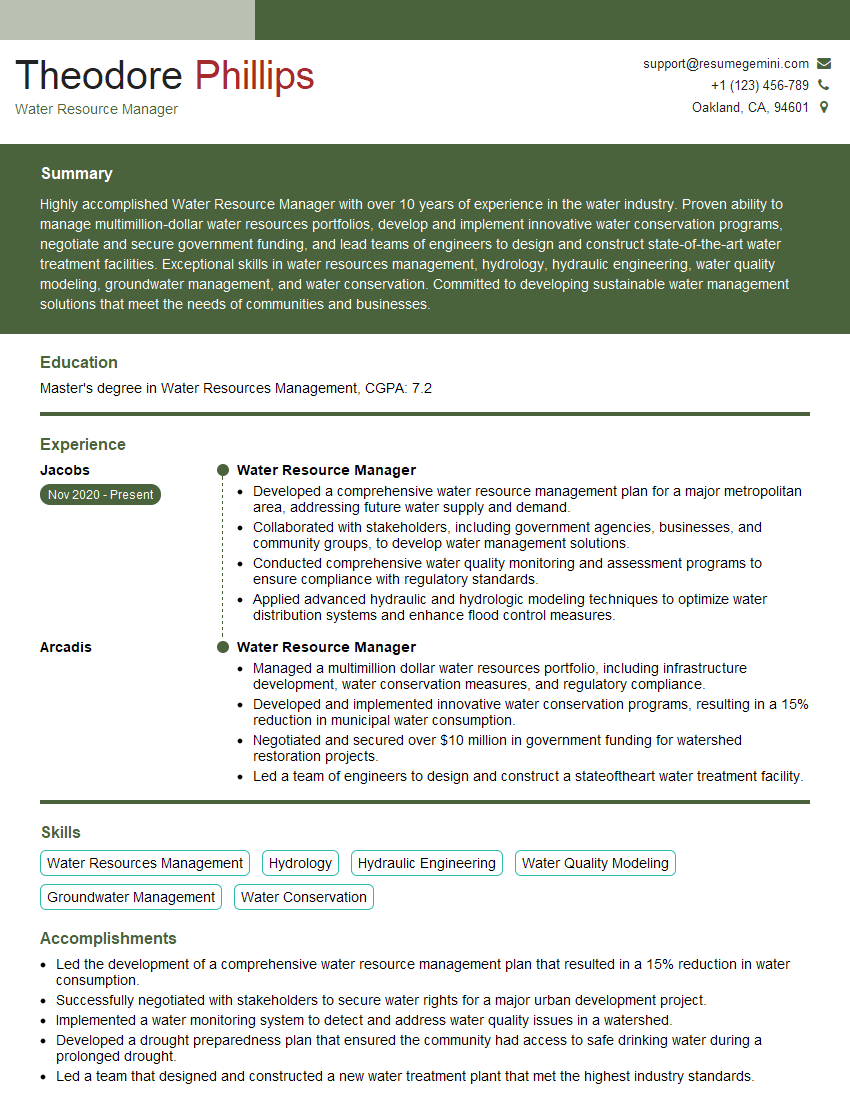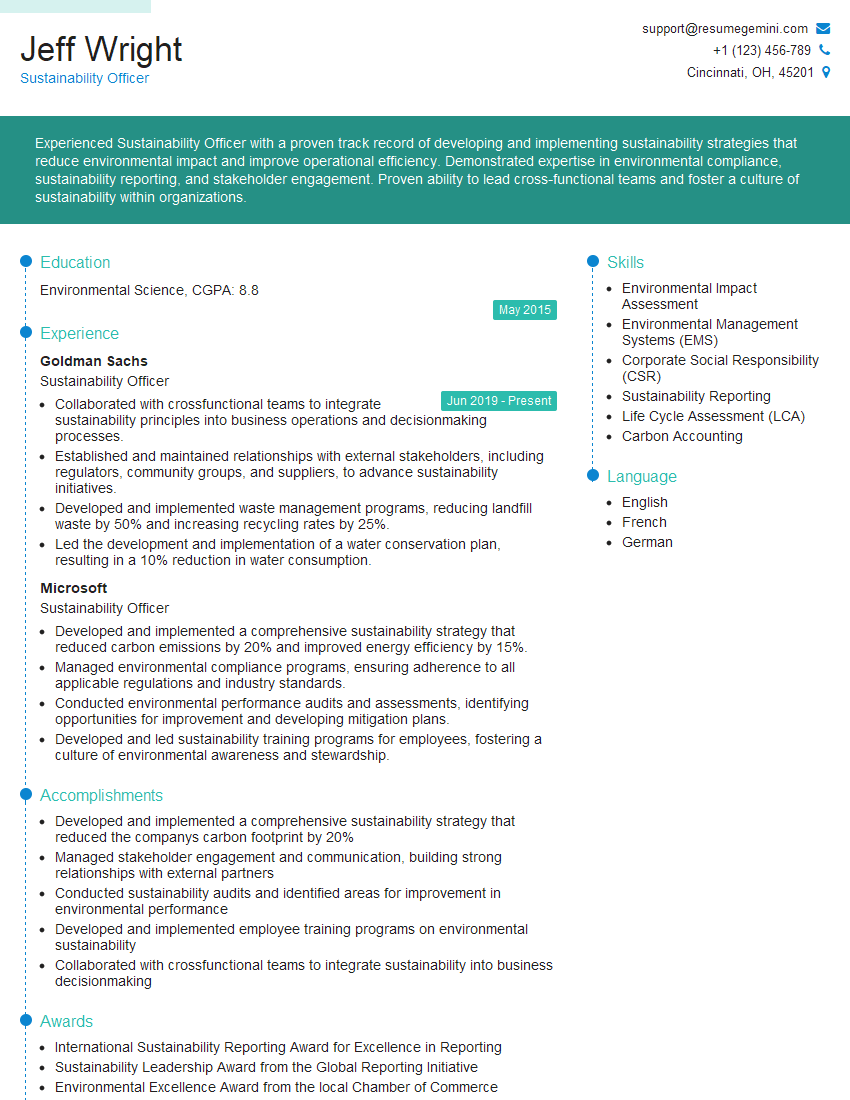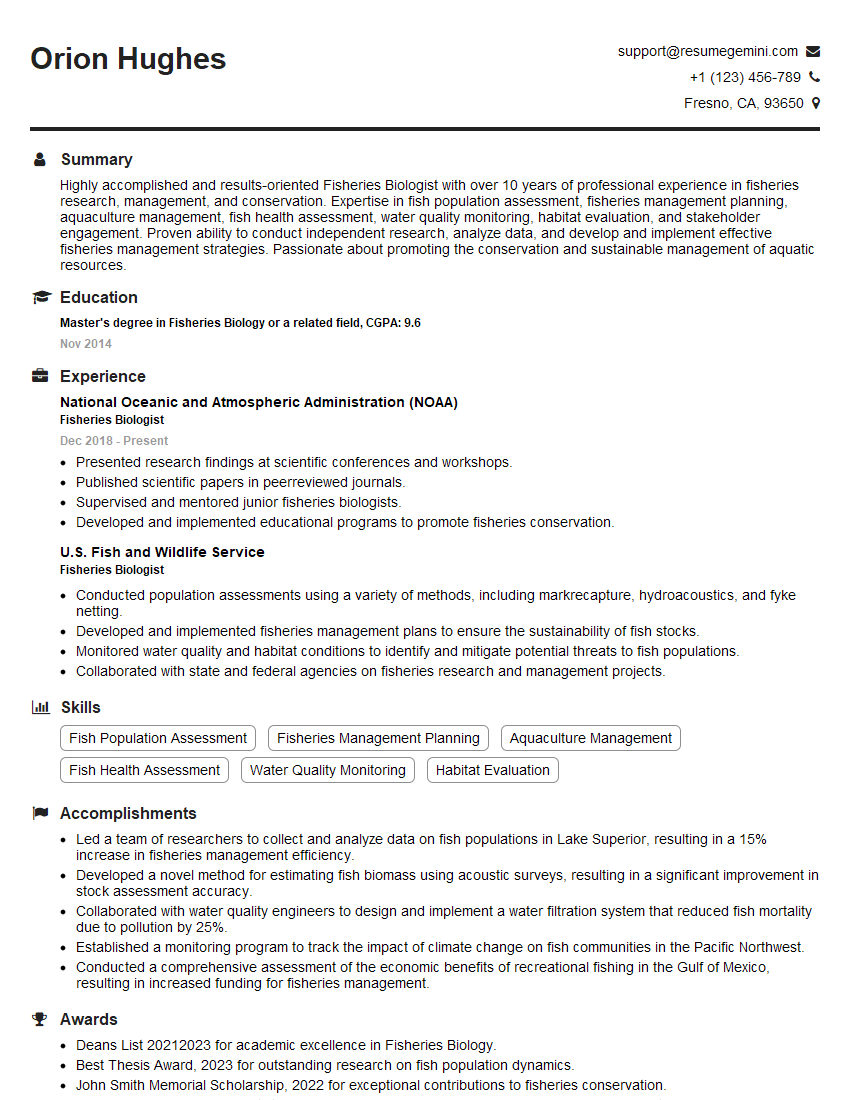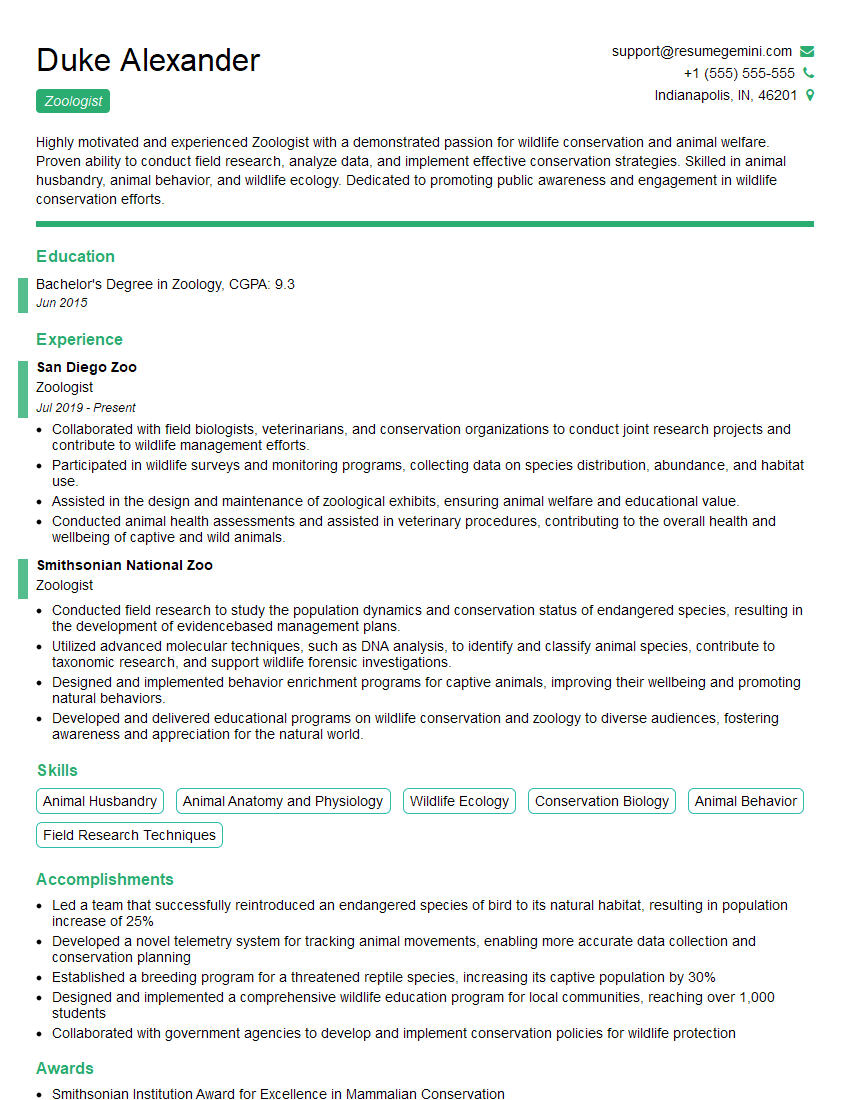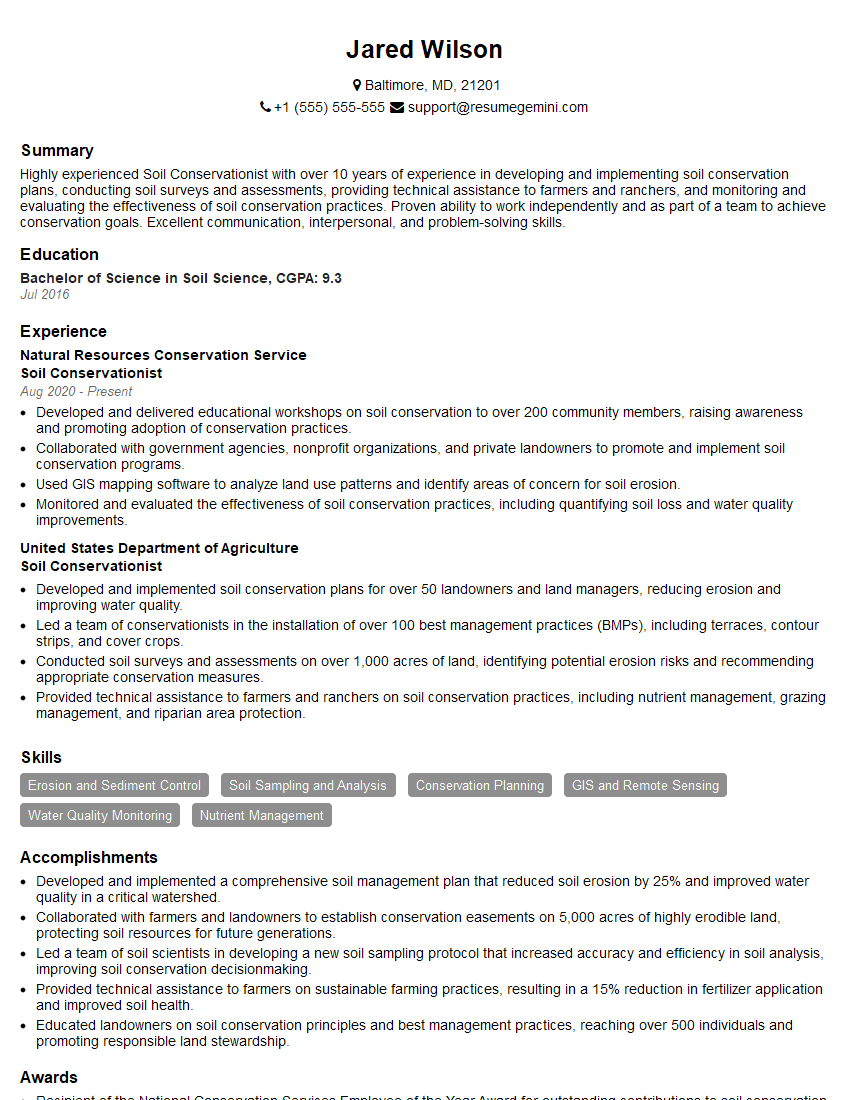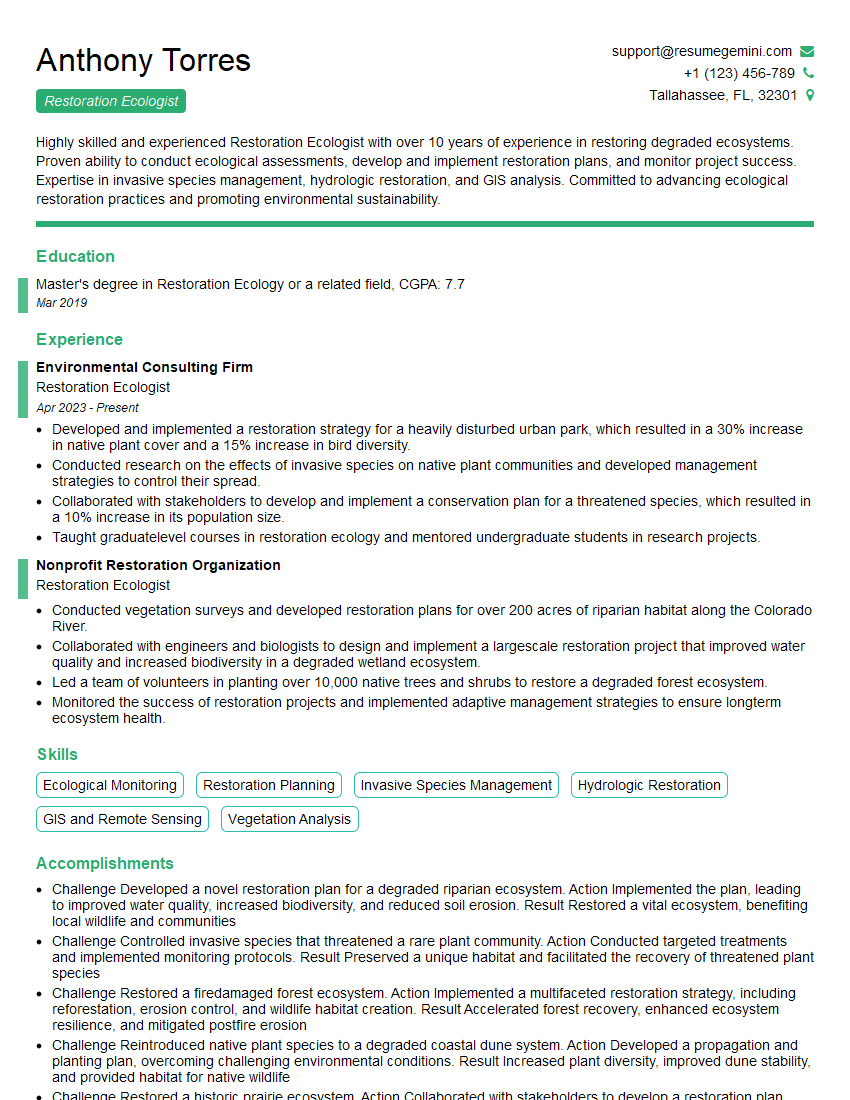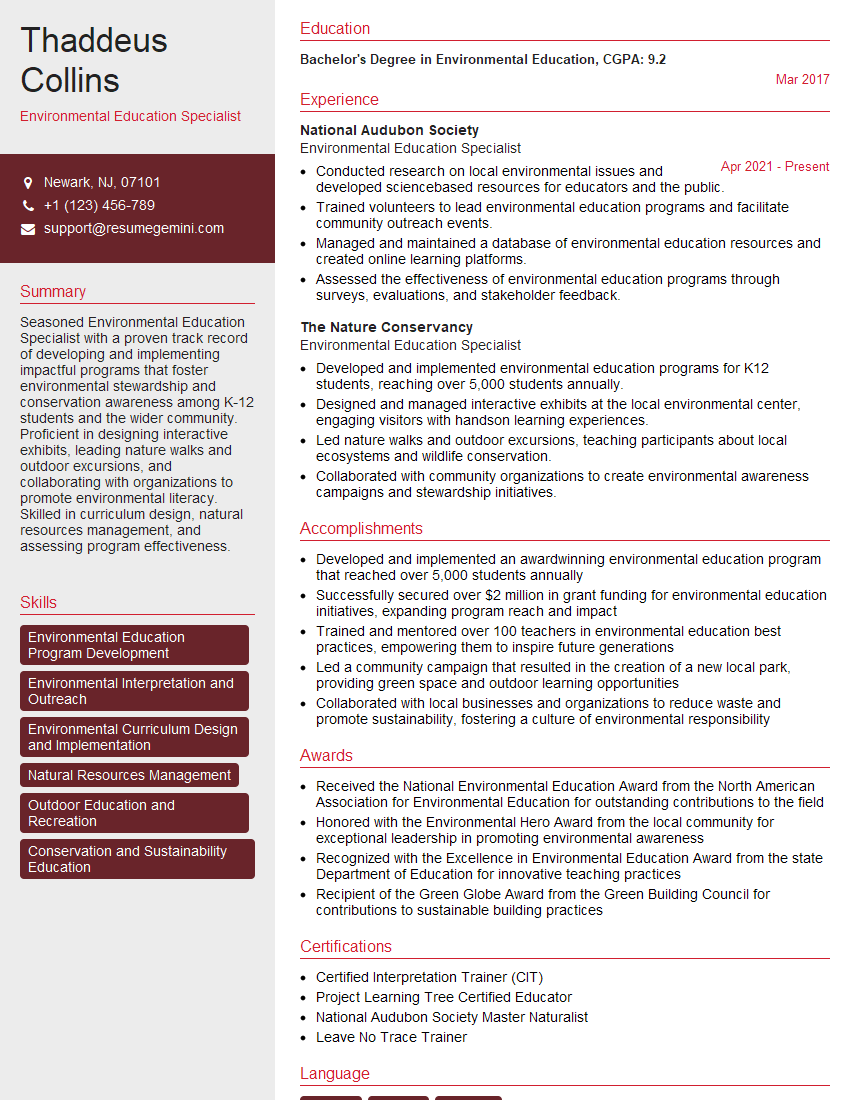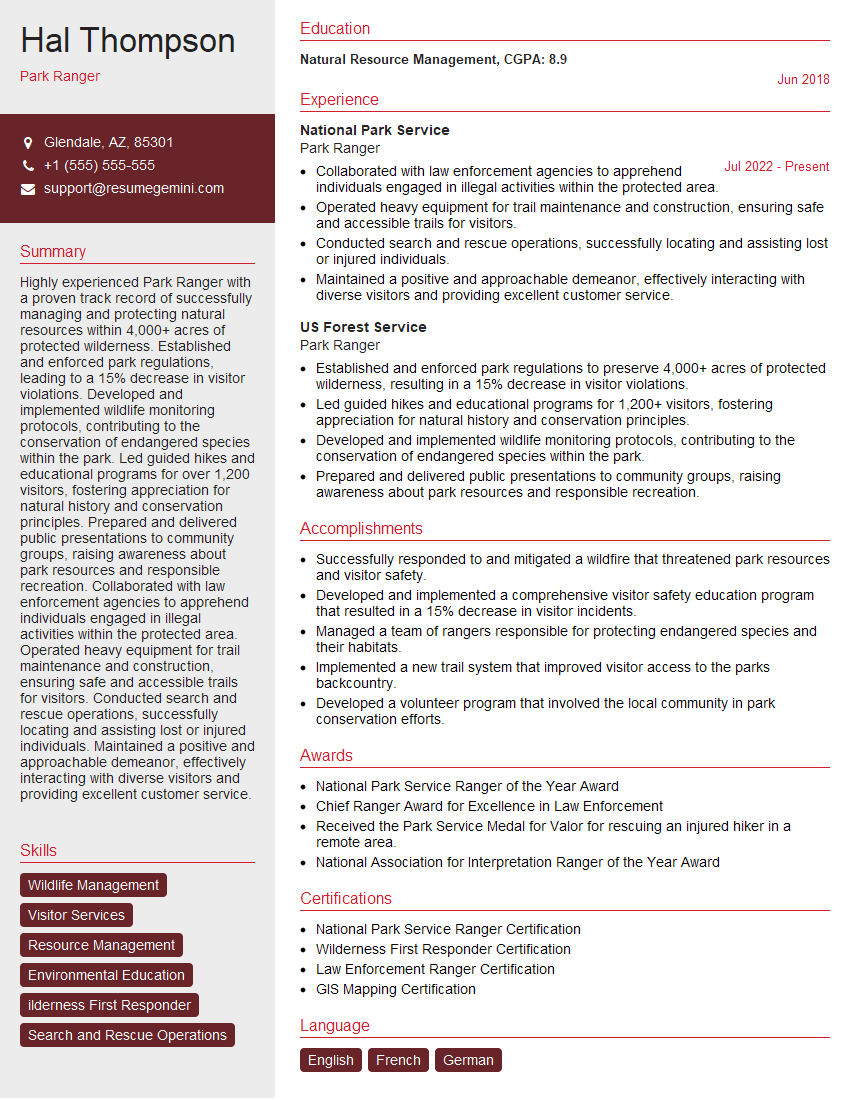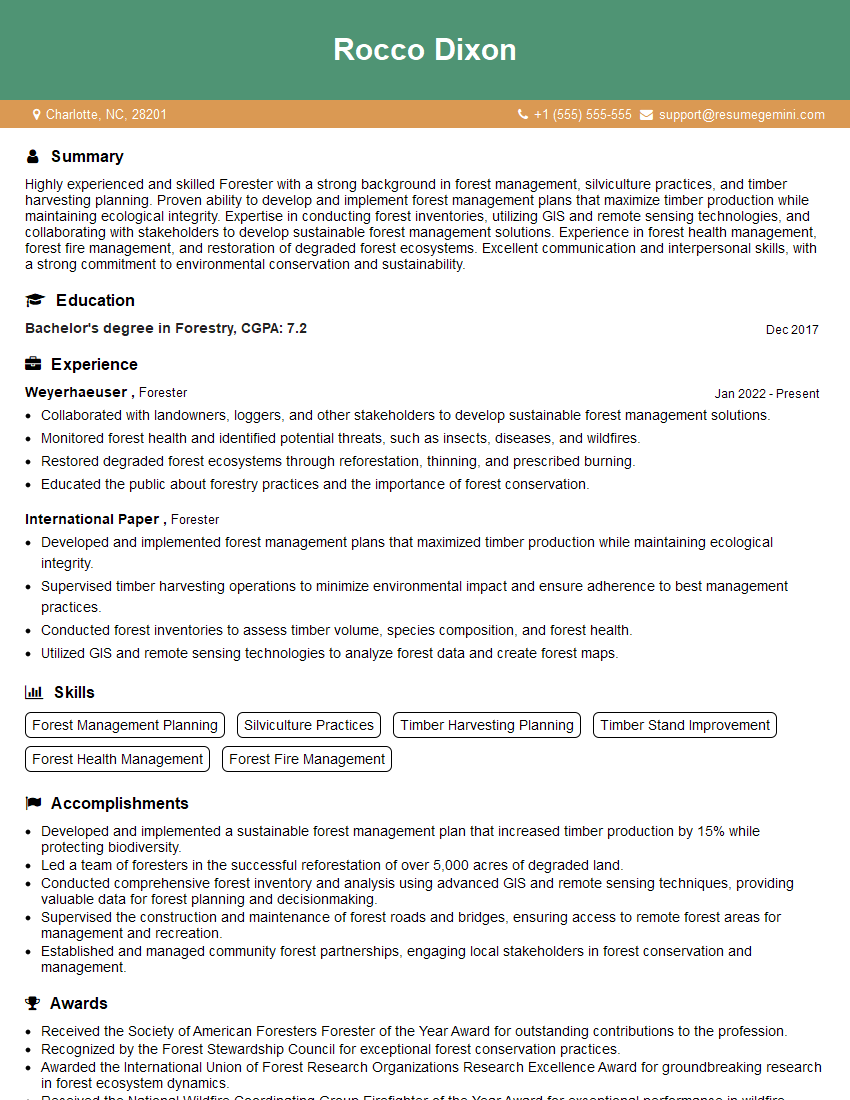The right preparation can turn an interview into an opportunity to showcase your expertise. This guide to Conservation Principles interview questions is your ultimate resource, providing key insights and tips to help you ace your responses and stand out as a top candidate.
Questions Asked in Conservation Principles Interview
Q 1. Define biodiversity and explain its importance in conservation.
Biodiversity refers to the variety of life on Earth at all its levels, from genes to ecosystems. It encompasses the evolutionary, ecological, and cultural processes that sustain life. Think of it as the intricate web of all living things and their interactions.
Its importance in conservation is paramount because biodiversity underpins the health of our planet. A diverse ecosystem is more resilient to disturbances like disease outbreaks or climate change. Each species plays a vital role, whether it’s pollination by bees, nutrient cycling by decomposers, or water purification by wetlands. Loss of biodiversity weakens this web, leading to ecosystem instability and ultimately threatening human well-being, as we depend on these ecosystems for food, clean water, and other essential resources.
For example, the loss of a keystone species – a species that plays a disproportionately large role in its ecosystem – can trigger a cascade effect, leading to the decline of other species. The loss of sea otters, for instance, can lead to an overabundance of sea urchins, which in turn devastate kelp forests.
Q 2. Explain the concept of ecological carrying capacity.
Ecological carrying capacity is the maximum population size of a species that an environment can sustain indefinitely, given the available resources and environmental conditions. It’s not a fixed number but rather a dynamic equilibrium shaped by factors such as food availability, water, shelter, and the presence of predators or diseases. Imagine a pond with a limited amount of algae: only a certain number of fish can survive long-term if the algae are their primary food source. Exceeding the carrying capacity leads to resource depletion, increased competition, and ultimately population decline through starvation, disease, or emigration.
Understanding carrying capacity is crucial in wildlife management. For example, conservationists need to estimate the carrying capacity of a habitat before reintroducing an endangered species to prevent overpopulation and subsequent habitat degradation. Overestimating carrying capacity can lead to population crashes, while underestimating it may limit the species’ recovery potential.
Q 3. Describe the difference between in-situ and ex-situ conservation.
In-situ conservation and ex-situ conservation are two primary approaches to protecting endangered species and ecosystems. In-situ conservation focuses on preserving species within their natural habitats, while ex-situ conservation involves protecting species outside their natural habitats.
- In-situ conservation involves creating protected areas like national parks and wildlife sanctuaries where species can live and reproduce naturally. This approach is preferred as it maintains the species’ genetic integrity and natural ecological interactions. Examples include establishing protected areas, implementing sustainable land management practices, and controlling poaching and habitat degradation.
- Ex-situ conservation involves removing species from their natural habitats and protecting them elsewhere. This could include zoos, botanical gardens, seed banks, or captive breeding programs. While helpful for species on the brink of extinction, ex-situ conservation can be challenging due to the need for artificial environments and potential loss of genetic diversity.
Think of it like this: in-situ is like protecting a house by securing it, while ex-situ is like rescuing the occupants and housing them somewhere else temporarily.
Q 4. What are the key principles of sustainable development?
Sustainable development aims to meet the needs of the present without compromising the ability of future generations to meet their own needs. It operates on three interconnected pillars:
- Environmental sustainability: Protecting and conserving natural resources like forests, water, and biodiversity. This includes minimizing pollution and waste, promoting renewable energy, and managing resources effectively.
- Economic sustainability: Ensuring economic growth that is equitable and long-term, not just focused on short-term gains. This includes promoting fair trade, investing in green technologies, and supporting sustainable businesses.
- Social sustainability: Fostering social equity and well-being. This includes providing access to education, healthcare, and opportunities for all, respecting human rights, and promoting social justice.
The key is finding a balance between these three pillars. For example, building a hydroelectric dam can generate clean energy (environmental), create jobs (economic), but may displace communities (social), highlighting the need for careful planning and consideration of all aspects.
Q 5. Explain the concept of habitat fragmentation and its impact on wildlife.
Habitat fragmentation occurs when large, continuous habitats are broken up into smaller, isolated patches. This is often caused by human activities such as deforestation, urbanization, and road construction. Imagine a forest being divided into small, disconnected islands by roads and agricultural fields.
The impact on wildlife is significant. Smaller patches support smaller populations, increasing the risk of extinction due to inbreeding, genetic bottlenecks, and reduced resilience to environmental changes. Fragmentation also limits species’ ability to move freely between habitats, hindering gene flow, foraging, and mating. It can create edge effects, where the conditions at the edges of the fragments differ from the interior, impacting species that are adapted to the core habitat. For instance, forest-dwelling birds may become more vulnerable to predators due to increased edge habitat exposure.
Q 6. Describe different approaches to wildlife management.
Wildlife management employs diverse approaches to maintain healthy populations and ecosystems. These can include:
- Habitat restoration and protection: Restoring degraded habitats and creating protected areas to provide adequate space and resources for wildlife.
- Population management: Techniques such as population surveys, controlling invasive species, and managing hunting and fishing to maintain healthy population levels.
- Disease management: Preventing and controlling wildlife diseases to minimize their impact on populations.
- Monitoring and research: Continuous monitoring of wildlife populations and habitats to inform management decisions and gain a better understanding of ecosystem dynamics.
- Community engagement: Involving local communities in wildlife conservation efforts to promote sustainable practices and ensure that conservation is locally relevant and beneficial.
For example, managing hunting pressure through licensing and setting bag limits is crucial for maintaining sustainable populations of game animals, preventing overexploitation, and ensuring the long-term health of the ecosystem.
Q 7. What are the major threats to biodiversity?
Biodiversity faces numerous threats, many stemming from human activities. The major ones include:
- Habitat loss and degradation: Deforestation, urbanization, and agriculture are major drivers of habitat loss and fragmentation.
- Climate change: Changes in temperature, precipitation patterns, and sea levels are altering habitats and impacting species distributions.
- Pollution: Air, water, and soil pollution contaminate habitats and harm wildlife.
- Invasive species: Non-native species can outcompete native species and disrupt ecosystem functions.
- Overexploitation: Overfishing, hunting, and poaching deplete wildlife populations.
Addressing these threats requires a multifaceted approach involving policy changes, technological innovations, community engagement, and international cooperation. For example, transitioning to sustainable agriculture practices can reduce habitat loss while promoting biodiversity-friendly farming techniques.
Q 8. Explain the role of protected areas in conservation.
Protected areas, such as national parks, wildlife reserves, and marine sanctuaries, are crucial for conservation. They act as havens for biodiversity, safeguarding threatened species and vital ecosystems from the impacts of human activities. Think of them as islands of safety in a sea of development.
Their role is multifaceted:
- Habitat preservation: They provide critical habitat for a wide range of species, ensuring their survival and preventing extinction.
- Species protection: Protected areas offer safe spaces for endangered species to breed and flourish, recovering their populations.
- Ecosystem services: They maintain vital ecosystem processes like carbon sequestration, water purification, and pollination, which benefit both the environment and humans.
- Research and education: They serve as important sites for scientific research, monitoring biodiversity trends, and educating the public about the importance of conservation.
- Recreation and tourism: Many protected areas provide opportunities for ecotourism, generating revenue that can support conservation efforts while also raising awareness.
For example, the Serengeti National Park in Tanzania protects a vast expanse of savanna, safeguarding iconic species like lions, elephants, and wildebeest. Without this protection, these species would face severe threats from habitat loss and poaching.
Q 9. Discuss the challenges of balancing conservation with human development.
Balancing conservation with human development is one of the biggest challenges facing our planet. It’s a constant negotiation between the needs of people and the needs of the environment. Often, these needs appear to be in direct conflict.
Challenges include:
- Competing land uses: Development often encroaches on natural habitats, leading to deforestation, habitat fragmentation, and biodiversity loss.
- Resource extraction: Mining, logging, and fishing can deplete natural resources and damage ecosystems.
- Pollution: Industrial activities and urbanization can pollute air, water, and soil, harming wildlife and human health.
- Climate change: The impacts of climate change exacerbate existing conservation challenges, leading to habitat shifts, sea-level rise, and increased frequency of extreme weather events.
- Poverty and lack of alternative livelihoods: People living in poverty may rely on unsustainable practices to survive, putting pressure on natural resources. Providing alternative livelihoods is crucial.
Effective solutions require integrated approaches, such as sustainable development planning, participatory decision-making involving local communities, and the creation of incentives for conservation.
For instance, eco-tourism initiatives can provide alternative income sources for local communities, reducing their reliance on destructive practices like logging. This fosters a sense of ownership and stewardship over their natural resources.
Q 10. How do you assess the effectiveness of a conservation program?
Assessing conservation program effectiveness requires a multi-faceted approach combining quantitative and qualitative data. It’s not just about counting the number of animals; it’s about understanding the entire system.
Key indicators include:
- Species population trends: Monitoring population sizes, genetic diversity, and distribution of target species provides insights into their conservation status.
- Habitat condition: Assessing the quality and extent of critical habitats helps evaluate the success of habitat restoration or protection efforts.
- Ecosystem functioning: Monitoring key ecosystem processes like nutrient cycling, water flow, and carbon sequestration demonstrates the overall health of the ecosystem.
- Community involvement and participation: Assessing the level of community engagement and support for the program helps determine its long-term sustainability.
- Socioeconomic impacts: Evaluating the program’s impact on local livelihoods and economic development is essential, especially when considering community-based conservation.
Methods include:
- Monitoring surveys and censuses: Regular surveys using techniques like camera trapping or mark-recapture help track population changes.
- Remote sensing: Satellites and drones provide valuable data on habitat extent, deforestation rates, and other environmental changes.
- Community feedback and participatory monitoring: Engaging local communities in monitoring and reporting helps to enhance data collection and build ownership.
A well-designed monitoring program uses a combination of these methods to provide a holistic assessment of the program’s effectiveness.
Q 11. Describe your understanding of ecosystem services.
Ecosystem services are the myriad of benefits that humans derive from natural ecosystems. These are not just things we can sell; they’re the essential life support systems our well-being depends on.
Examples include:
- Provisioning services: These are the tangible goods we obtain from ecosystems, such as food (fish, crops), fresh water, timber, and fuelwood.
- Regulating services: These are the benefits obtained from the regulation of ecosystem processes, including climate regulation (carbon sequestration), water purification, pollination, and disease control.
- Supporting services: These are the fundamental processes that underpin all other ecosystem services, such as nutrient cycling, soil formation, and primary production.
- Cultural services: These are the non-material benefits we derive from ecosystems, such as recreation, tourism, spiritual enrichment, and aesthetic appreciation.
Understanding ecosystem services is crucial for conservation because it highlights the economic and social value of nature. When we quantify the benefits we get from healthy ecosystems, it creates a powerful argument for their protection. For example, the economic value of pollination services provided by bees and other insects to agriculture is immense. Protecting pollinator habitats becomes an economically-sound strategy.
Q 12. What is the role of climate change in conservation challenges?
Climate change is a major threat multiplier, exacerbating existing conservation challenges and creating new ones. It’s not just about rising temperatures; it’s about a cascade of interconnected effects.
Impacts include:
- Habitat loss and fragmentation: Changes in temperature and precipitation patterns can lead to shifts in species distributions, altering habitats and making them less suitable for some species.
- Sea-level rise: Rising sea levels threaten coastal ecosystems like mangroves, salt marshes, and coral reefs, which are important biodiversity hotspots.
- Ocean acidification: Increased CO2 in the atmosphere dissolves in the ocean, making it more acidic and harming marine life, particularly shellfish and coral.
- Increased frequency and intensity of extreme weather events: Hurricanes, droughts, and wildfires can cause widespread habitat destruction and species mortality.
- Range shifts and species interactions: Species may migrate to higher altitudes or latitudes, leading to altered species interactions and competition for resources.
Addressing climate change requires a two-pronged approach: mitigating greenhouse gas emissions and adapting to the unavoidable impacts of climate change. Conservation strategies need to incorporate climate change considerations, such as creating climate refugia (areas less affected by climate change), assisted migration (helping species relocate), and building resilience into ecosystems.
Q 13. Explain the concept of ecological restoration.
Ecological restoration is the process of assisting the recovery of an ecosystem that has been degraded, damaged, or destroyed. It’s about actively repairing the damage and helping nature heal itself. It’s not just planting trees; it’s about recreating the entire functioning ecosystem.
Key aspects include:
- Identifying the degradation: Determining the causes and extent of ecosystem degradation is the first step. This often involves historical research and ecological assessments.
- Setting restoration goals: Defining clear and measurable goals for the restoration process is crucial, such as restoring species diversity, improving water quality, or increasing carbon sequestration.
- Choosing appropriate restoration techniques: Selecting appropriate techniques depends on the type of ecosystem and the extent of degradation. This could include removing invasive species, reintroducing native species, improving soil conditions, or restoring hydrology.
- Monitoring and evaluation: Regular monitoring is essential to assess the effectiveness of the restoration efforts and to make adjustments as needed.
Successful ecological restoration requires a thorough understanding of the ecosystem’s structure and function, and often involves collaboration among scientists, land managers, and local communities.
For example, restoring degraded wetlands might involve removing pollutants, re-establishing natural water flow, and replanting native wetland vegetation. This would lead to improved water quality, increased biodiversity, and enhanced flood control.
Q 14. How do you use GIS in conservation planning?
Geographic Information Systems (GIS) are indispensable tools for conservation planning. They allow us to visualize, analyze, and manage spatial data related to biodiversity, habitats, and human activities. Think of it as a powerful map-making and analysis software specifically for conservation.
Applications include:
- Habitat mapping and analysis: GIS can be used to map different habitats, assess their quality, and identify areas of high biodiversity.
- Species distribution modeling: GIS helps predict species distributions based on environmental factors, allowing for targeted conservation efforts.
- Protected area planning and design: GIS assists in selecting and designing protected areas based on criteria such as biodiversity representation, connectivity, and human impacts.
- Monitoring and evaluating conservation programs: GIS enables the tracking of changes in habitat extent, species populations, and other relevant indicators over time.
- Connectivity analysis: GIS helps identify corridors and stepping stones that connect fragmented habitats, facilitating species movement and gene flow.
For example, using GIS, we can overlay data on species occurrences, habitat suitability, and human land use to identify priority areas for conservation. This allows for a more strategic and effective allocation of conservation resources.
Example code (conceptual):// Load species distribution data and habitat suitability data into GIS.
// Overlay the layers to identify areas of high species richness and habitat suitability.
// Perform spatial analysis to select optimal locations for new protected areas.
Q 15. What are the ethical considerations in conservation?
Ethical considerations in conservation are multifaceted and often involve navigating complex conflicts between human needs and environmental protection. At the core, it’s about ensuring fairness and justice in decision-making processes that affect both people and nature.
- Intergenerational Equity: This principle emphasizes the responsibility to conserve resources not just for our generation but for future generations. For example, depleting fisheries beyond sustainable levels compromises the ability of future generations to benefit from this resource.
- Intrinsic Value of Nature: This acknowledges that nature possesses inherent worth, irrespective of its usefulness to humans. This challenges anthropocentric views and supports the protection of species and ecosystems even if they don’t provide direct economic benefits.
- Environmental Justice: This demands that the burdens and benefits of conservation efforts are distributed fairly, particularly considering the disproportionate impact of environmental degradation on marginalized communities. For instance, ensuring that protected areas don’t displace indigenous populations or restrict their access to resources.
- Precautionary Principle: This suggests that where there are threats of serious or irreversible environmental damage, lack of full scientific certainty should not be used as a reason for postponing cost-effective measures to prevent environmental degradation. For example, implementing stricter regulations on pollutants even if their long-term effects aren’t fully understood.
Ultimately, ethical conservation demands thoughtful consideration of all stakeholders, a commitment to transparency and accountability, and a willingness to make difficult choices to ensure the long-term health of the planet.
Career Expert Tips:
- Ace those interviews! Prepare effectively by reviewing the Top 50 Most Common Interview Questions on ResumeGemini.
- Navigate your job search with confidence! Explore a wide range of Career Tips on ResumeGemini. Learn about common challenges and recommendations to overcome them.
- Craft the perfect resume! Master the Art of Resume Writing with ResumeGemini’s guide. Showcase your unique qualifications and achievements effectively.
- Don’t miss out on holiday savings! Build your dream resume with ResumeGemini’s ATS optimized templates.
Q 16. Discuss different conservation funding mechanisms.
Conservation funding is crucial for implementing effective strategies. Diverse mechanisms are employed, each with its own strengths and weaknesses.
- Government Funding: National and international agencies allocate significant funds for conservation through designated budgets and grants. This can be a reliable source but may be subject to political priorities and budget limitations.
- Private Philanthropy: Foundations, corporations, and individuals contribute significantly. This funding can be flexible but may be less predictable and often focuses on specific projects or regions. Examples include the significant contributions of the Gordon and Betty Moore Foundation to marine conservation.
- Impact Investing: This involves investments in projects that generate both financial returns and positive environmental impact. This approach aligns financial goals with conservation outcomes but requires careful due diligence to ensure both profitability and conservation effectiveness.
- Carbon Markets: These incentivize carbon sequestration projects, like forest conservation or reforestation, by allowing organizations to purchase carbon credits. This market-based approach can provide a significant funding source but depends on robust monitoring and verification mechanisms to prevent fraud.
- Ecotourism: Revenue generated from responsible tourism can directly benefit conservation efforts by providing funding for protected areas and community-based projects. However, sustainable management is crucial to prevent negative impacts from tourism.
Securing diverse funding streams is essential for long-term conservation sustainability. A strategic approach requires careful planning, effective proposal writing, and building strong relationships with potential funders.
Q 17. Explain the importance of community involvement in conservation.
Community involvement is paramount to successful conservation. Local communities are the custodians of their environment and their knowledge, participation, and support are essential for long-term success.
- Local Ecological Knowledge (LEK): Indigenous and local communities possess invaluable traditional knowledge about their ecosystems. Integrating this knowledge into conservation planning leads to more effective and culturally appropriate strategies.
- Improved Compliance and Enforcement: When communities are actively involved, they are more likely to comply with conservation regulations and participate in enforcement efforts. This reduces reliance on external authorities and strengthens local ownership.
- Sustainable Livelihoods: Conservation initiatives that support sustainable livelihoods for local communities help alleviate poverty and reduce pressure on natural resources. This can include supporting alternative income sources such as ecotourism or sustainable harvesting practices.
- Conflict Resolution: Community participation provides a platform for addressing conflicts arising from resource management and land use planning. This proactive approach prevents potential disputes and promotes collaboration.
Effective community engagement requires participatory approaches, genuine respect for local cultures, and equitable sharing of benefits. It’s a process that requires careful planning, ongoing dialogue, and a commitment to building trust.
Q 18. How do you prioritize conservation efforts?
Prioritizing conservation efforts requires a systematic approach based on several key factors. A common framework involves a combination of:
- Biodiversity Hotspots: Areas with high concentrations of endemic species are prioritized to maximize the protection of unique biodiversity. These areas are often under significant threat, necessitating urgent action.
- Threat Assessment: Identifying the most pressing threats to biodiversity, such as habitat loss, invasive species, or climate change, helps focus efforts where they will have the greatest impact. This requires robust data analysis and expert judgment.
- Cost-Effectiveness: Conservation actions are evaluated based on their effectiveness per unit of investment. Prioritizing cost-effective strategies maximizes the impact of limited resources. This might involve comparing the cost of protecting a large area versus managing smaller, crucial habitats effectively.
- Ecosystem Services: Conserving areas that provide critical ecosystem services (e.g., clean water, carbon sequestration) can deliver multiple benefits, including economic and social advantages. This holistic approach balances ecological and human needs.
- Irreplaceability: Protecting unique and irreplaceable habitats and species is crucial. Losing these components of biodiversity would be particularly damaging to the ecosystem.
Prioritization is an iterative process involving ongoing monitoring, evaluation, and adaptation based on new information and changing circumstances.
Q 19. Describe your experience with data analysis in conservation.
Data analysis plays a critical role in modern conservation. My experience involves using various techniques to understand ecological patterns, assess threats, and evaluate the effectiveness of conservation interventions.
- Species Distribution Modeling: I’ve used tools like MaxEnt and ArcGIS to predict species distributions based on environmental variables, which helps identify areas critical for conservation.
- Population Viability Analysis (PVA): Using population modeling software, I’ve assessed the long-term survival probability of threatened species under different scenarios, helping to inform management decisions.
- Remote Sensing and GIS: I regularly analyze satellite imagery and GIS data to monitor deforestation rates, habitat fragmentation, and changes in land use, providing crucial information for conservation planning.
- Statistical Analysis: I use statistical software (e.g., R) to analyze ecological data, assess the effectiveness of conservation interventions, and identify correlations between environmental factors and species populations.
For example, in a recent project, we used GPS tracking data to analyze the movement patterns of a critically endangered primate. This data informed the design of a protected area that effectively encompassed its entire home range. This required proficiency in statistical modeling, GIS software, and collaborative work with field researchers.
Q 20. How do you communicate complex conservation issues to a non-technical audience?
Communicating complex conservation issues to a non-technical audience requires clear, concise, and engaging language. The key is to connect with the audience on an emotional and personal level.
- Storytelling: Using narratives about animals, ecosystems, or communities affected by conservation challenges can evoke empathy and increase understanding. Sharing personal anecdotes or highlighting success stories can strengthen this approach.
- Visual Communication: Employing compelling images, maps, and graphs to illustrate key points makes information more accessible and memorable. Simple visuals are more effective than overly complex ones.
- Analogies and Metaphors: Relating complex concepts to everyday experiences makes them easier to grasp. For example, comparing the interconnectedness of an ecosystem to a spider web helps convey the idea of ecological interdependence.
- Interactive Presentations: Using interactive tools, games, or workshops can make learning about conservation fun and engaging, particularly for younger audiences. This can transform a passive learning experience into an active engagement.
- Tailoring the message: Different audiences will respond to different messaging. Consider the audience’s prior knowledge, values, and interests when developing communication materials.
Effective communication is crucial for building public support for conservation and fostering a sense of shared responsibility for protecting the planet.
Q 21. What are the legal frameworks governing conservation in your region?
(Note: This answer will vary depending on the region. The following is a general example reflecting common legal frameworks found in many jurisdictions.)
Legal frameworks governing conservation vary by region but generally involve a combination of national and international laws, regulations, and policies. These aim to protect biodiversity, manage natural resources, and mitigate environmental harm.
- National Environmental Laws: These laws provide the overarching framework for environmental protection within a country. They often establish protected areas, regulate pollution, and manage natural resources. Specific examples might include legislation concerning endangered species, water quality standards, or air pollution controls.
- International Treaties and Conventions: Many countries are signatories to international agreements like the Convention on Biological Diversity (CBD) or the Convention on International Trade in Endangered Species (CITES). These treaties establish global commitments and standards for conservation.
- Protected Area Legislation: Laws establish and manage protected areas, like national parks or wildlife reserves. These laws define permitted activities, restrict access in certain areas, and establish management plans.
- Resource Management Legislation: Laws governing the use and extraction of natural resources (e.g., forestry, fishing, mining) include regulations aimed at sustainable use and conservation. These often incorporate licensing systems, quotas, and environmental impact assessments.
- Environmental Impact Assessment (EIA) Regulations: Projects with significant environmental impacts require EIAs to assess potential risks and propose mitigation measures. This helps prevent harm to the environment and ensures informed decision-making.
Effective enforcement of these laws is crucial for ensuring compliance and achieving conservation goals. This requires a strong regulatory framework, adequate resources for monitoring and enforcement, and mechanisms for addressing violations.
Q 22. Explain the concept of invasive species and their management.
Invasive species are non-native organisms that, when introduced to a new environment, cause significant ecological and/or economic harm. Their success often stems from a lack of natural predators, competitors, or diseases in the new habitat, allowing them to outcompete native species for resources. Management involves a multi-pronged approach.
- Prevention: This is the most cost-effective strategy. Strict biosecurity measures at ports and borders, preventing the accidental or intentional introduction of invasive species through things like ballast water in ships or contaminated soil on imported goods, are crucial.
- Early Detection and Rapid Response: Early detection systems, often involving citizen science initiatives and monitoring programs, allow for swift eradication or containment before widespread establishment. This might involve physical removal, targeted pesticide use, or biological control.
- Control and Eradication: Once established, eradication is difficult but sometimes feasible for smaller infestations. Control measures might include mechanical removal (e.g., hand-pulling weeds), chemical control (herbicides, pesticides), or biological control (introducing natural predators or pathogens). The choice depends heavily on the species, its ecosystem impact, and available resources.
- Restoration: After control or eradication, restoring the native ecosystem is essential. This might involve reintroducing native plants, rehabilitating degraded habitats, and monitoring the recovery of the ecosystem’s biodiversity.
For example, the control of the brown tree snake in Guam involved a combination of trapping, baiting, and the introduction of specific snake-eating species (though this is controversial and requires careful consideration). Successful management requires a strong understanding of the species’ biology, its interactions with the ecosystem, and the socio-economic implications of the invasion.
Q 23. Describe your experience with environmental impact assessments.
I have extensive experience conducting and reviewing Environmental Impact Assessments (EIAs). EIAs are crucial tools for evaluating the potential environmental consequences of proposed projects, ensuring they align with sustainability goals. My work has encompassed a wide array of projects, including infrastructure development (roads, dams), mining operations, and renewable energy projects. The process typically involves:
- Scoping: Identifying the potential environmental impacts and establishing the study area.
- Baseline Data Collection: Gathering information on the existing environment (e.g., biodiversity, water quality, air quality).
- Impact Prediction: Assessing the likely effects of the project on the environment, using modelling and expert judgment.
- Mitigation Planning: Developing strategies to minimize or avoid negative impacts and enhance positive impacts.
- Reporting: Producing a comprehensive report summarizing the findings and recommendations.
- Review and Approval: The EIA undergoes a formal review process by relevant regulatory bodies.
In one notable project, we successfully identified a critical nesting habitat for an endangered bird species during the EIA for a highway construction project. This allowed us to reroute a section of the highway, avoiding significant harm to the bird population and achieving environmental compliance while accommodating project needs.
Q 24. How do you monitor and evaluate the success of conservation projects?
Monitoring and evaluation (M&E) are essential for determining the effectiveness of conservation projects. This involves establishing clear goals and measurable indicators at the project’s outset. These indicators should reflect the project’s objectives, whether it’s increasing population size, improving habitat quality, or changing community attitudes.
Monitoring involves the systematic collection of data on these indicators over time. This might include population counts, habitat surveys, water quality tests, or social surveys. Evaluation involves analyzing the data to determine the project’s progress towards its goals. It often incorporates quantitative data analysis but also qualitative data from interviews, focus groups, or observations to understand the impact’s broader implications.
For instance, in a project focused on restoring a degraded wetland, we monitored water quality parameters (e.g., nutrient levels, dissolved oxygen), plant community composition, and bird species diversity. Regular assessments helped us adapt our strategies, leading to improved results. Successful M&E requires careful planning, robust data collection methods, and rigorous analysis to draw credible conclusions. The use of adaptive management principles (discussed further below) allows for course correction and increases the likelihood of successful conservation outcomes.
Q 25. What is your understanding of conservation genetics?
Conservation genetics plays a vital role in conservation efforts by applying genetic principles to understand and manage biodiversity. It helps us:
- Assess genetic diversity: Low genetic diversity can make populations vulnerable to disease, environmental change, and inbreeding depression. Genetic analysis can quantify this diversity.
- Identify distinct populations: Understanding genetic differentiation among populations helps guide conservation strategies, such as identifying priority areas for protection or designing effective translocations.
- Monitor inbreeding and outbreeding: Managing mating systems to avoid inbreeding and facilitate genetic exchange is critical for maintaining healthy populations.
- Develop captive breeding programs: Genetic information helps select breeding pairs to maximize genetic diversity and minimize inbreeding in captive populations.
- Assess the impact of fragmentation: Genetic data can demonstrate how habitat fragmentation affects gene flow and genetic diversity.
For example, in a study of an endangered primate species, we used microsatellite markers to assess genetic diversity within and between populations, identifying populations with low diversity that required urgent conservation action.
Q 26. Explain your experience with stakeholder engagement in conservation projects.
Stakeholder engagement is paramount in successful conservation projects. It involves actively involving all parties who are affected by or have an interest in a project. This includes local communities, indigenous groups, government agencies, NGOs, and the private sector. Effective engagement necessitates:
- Identifying key stakeholders: Early identification and thorough understanding of the needs and perspectives of stakeholders are crucial.
- Building trust and relationships: Open communication, transparency, and mutual respect build trust and encourage cooperation.
- Participatory approaches: Employing participatory methods (e.g., workshops, focus groups, community meetings) enables stakeholders to actively participate in decision-making.
- Conflict resolution: Addressing potential conflicts and finding compromises is vital.
- Benefit sharing: Ensuring that local communities benefit from conservation projects increases their support and participation.
In a community-based conservation project, we worked closely with local communities to develop a sustainable tourism plan around a protected area. This involved joint planning, capacity building, and a benefit-sharing agreement, resulting in community ownership and effective protection of the area.
Q 27. Describe different approaches to pollution control related to conservation.
Pollution control is integral to conservation. Approaches vary depending on the pollutant and context but generally include:
- Source reduction: Minimizing pollution at its source is the most effective approach. This includes improving industrial processes, promoting sustainable agriculture, and reducing reliance on fossil fuels.
- Wastewater treatment: Treating wastewater before its release into the environment is essential to remove pollutants. This includes using technologies such as sewage treatment plants and constructed wetlands.
- Air pollution control: Reducing air pollutants (e.g., particulate matter, greenhouse gases) involves using cleaner energy sources, implementing emission standards, and promoting energy efficiency.
- Remediation: Cleaning up existing pollution involves techniques such as bioremediation (using microorganisms to break down pollutants), phytoremediation (using plants to absorb pollutants), and physical removal of contaminated soil or sediment.
- Policy and regulation: Effective legislation and enforcement are crucial to regulate pollution and encourage sustainable practices.
For example, restoring water quality in a polluted river might involve a combination of wastewater treatment improvements, reducing agricultural runoff, and implementing riparian buffer zones to filter pollutants.
Q 28. What are the key principles of adaptive management in conservation?
Adaptive management is a structured, iterative approach to conservation that embraces uncertainty. It recognizes that our understanding of ecosystems is often incomplete and that management strategies need to be adjusted based on monitoring results. Key principles include:
- Learning by doing: Management actions are viewed as experiments, providing opportunities to learn and improve.
- Monitoring and evaluation: Continuous monitoring allows for assessment of the effectiveness of management interventions.
- Flexibility and adjustment: Management strategies are adapted based on monitoring data and new information.
- Collaboration and stakeholder engagement: Involving stakeholders in the decision-making process fosters support and ensures management actions are socially acceptable.
- Transparency and accountability: Openly sharing information and lessons learned promotes transparency and accountability.
Imagine managing a population of endangered fish. An initial strategy might focus on habitat restoration. Monitoring reveals the strategy is only partially successful. Adaptive management would then involve adjusting the strategy, perhaps incorporating population augmentation through captive breeding, based on the observed results. This iterative process, involving learning from successes and failures, is crucial for effective conservation in complex and dynamic ecosystems.
Key Topics to Learn for Conservation Principles Interview
- Biodiversity Conservation: Understanding biodiversity hotspots, threats to biodiversity (habitat loss, climate change, pollution), and conservation strategies like protected areas, species recovery programs, and habitat restoration.
- Ecosystem Management: Practical application of ecological principles to manage and protect ecosystems. This includes understanding ecosystem services, carrying capacity, and the impact of human activities on ecosystem health.
- Sustainable Resource Management: Exploring principles of sustainable forestry, fisheries management, and water resource management. This involves balancing resource use with long-term ecological sustainability.
- Climate Change Mitigation and Adaptation: Understanding the science of climate change, its impacts on biodiversity and ecosystems, and strategies for mitigation (reducing greenhouse gas emissions) and adaptation (adjusting to the impacts of climate change).
- Conservation Policy and Legislation: Familiarizing yourself with relevant national and international conservation laws, policies, and agreements. This includes understanding the role of government agencies and NGOs in conservation.
- Conservation Planning and Implementation: Developing and implementing effective conservation plans, including setting goals, prioritizing actions, monitoring progress, and adapting strategies as needed. This often involves stakeholder engagement and collaborative approaches.
- Protected Area Management: Understanding the different types of protected areas (national parks, wildlife reserves, etc.), their management challenges, and best practices for their effective management.
- Environmental Impact Assessment (EIA): Knowing the process of conducting EIAs to evaluate the potential environmental impacts of development projects and proposing mitigation measures.
Next Steps
Mastering Conservation Principles is crucial for a successful and impactful career in environmental science and conservation. A strong understanding of these principles will significantly enhance your interview performance and open doors to exciting opportunities. To further boost your job prospects, creating an Applicant Tracking System (ATS)-friendly resume is essential. This ensures your qualifications are effectively highlighted to recruiters. We strongly recommend using ResumeGemini, a trusted resource, to build a professional and compelling resume. ResumeGemini provides examples of resumes tailored to Conservation Principles, helping you showcase your skills and experience in the best possible light.
Explore more articles
Users Rating of Our Blogs
Share Your Experience
We value your feedback! Please rate our content and share your thoughts (optional).
What Readers Say About Our Blog
Hi, I represent an SEO company that specialises in getting you AI citations and higher rankings on Google. I’d like to offer you a 100% free SEO audit for your website. Would you be interested?
good
